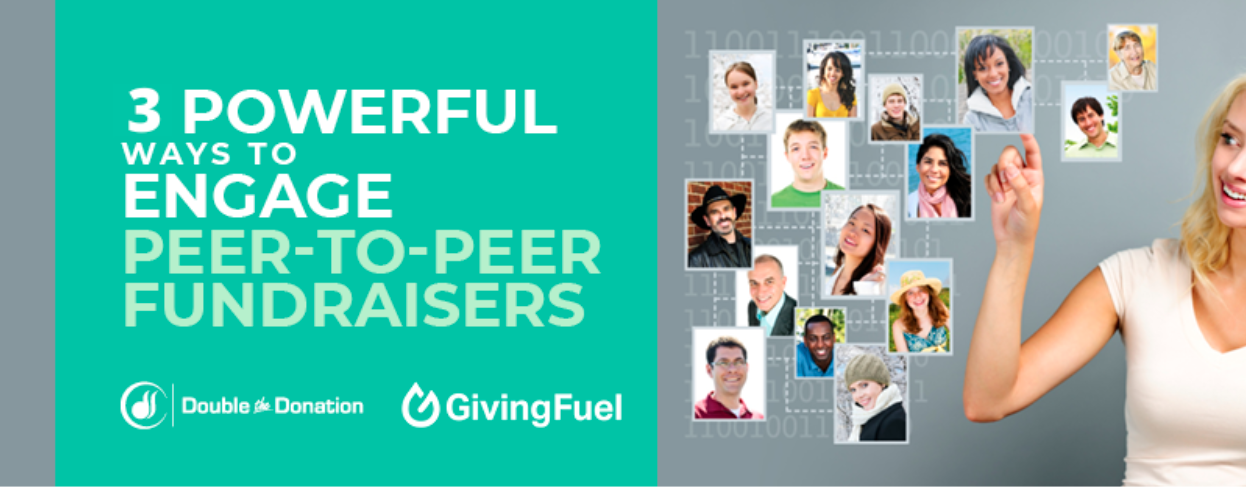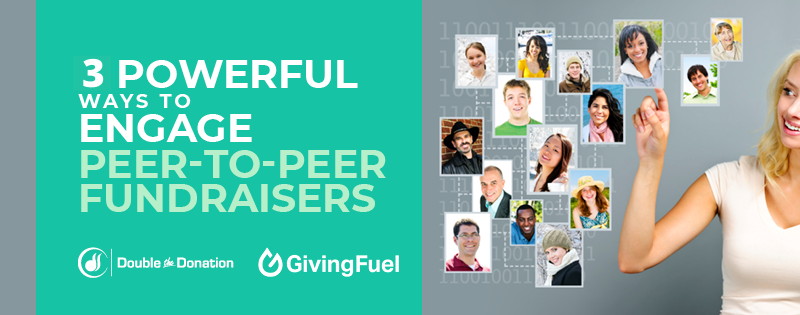

3 Powerful Ways to Engage Peer-to-Peer Fundraisers
Peer-to-peer fundraising campaigns are designed to aid nonprofits to raise more and reach new support. Find ou

Peer-to-peer (also known as P2P or social fundraising) strategies enable nonprofits to engage with supporters on a new level. Rather than contributing a few dollars directly to a fundraising campaign, P2P efforts empower individuals to take on a fundraising role. Fundraisers are then encouraged to solicit donations from their own personal networks of friends, family members, colleagues, and more.
Keeping a team of personal fundraisers engaged is essential for optimizing these efforts. Looking for ideas? Here are three of our favorites:
- Provide templates and resources.
- Encourage goal-setting and track progress.
- Double the stakes with matching gifts.
Get ready to elevate your peer-to-peer efforts—and better support the fundraisers supporting your cause! Let’s dive in with our first key engagement practice.
1. Provide templates and resources.
One of the most impactful things you can do as an organization to increase the results of your peer-to-peer fundraising efforts is to proactively equip your fundraising team with everything they need to be successful. When nonprofit supporters feel more prepared for their roles as volunteer fundraisers, they’ll be more effective at raising money and more engaged in the campaign.
And remember—even established fundraising professionals can become nervous about soliciting donations for the cause. For many of your volunteer fundraisers, it will be their first time acting in a fundraising role, so it’s important that you’re ready to walk alongside them throughout the process.
That’s why we recommend providing each individual with customizable donation request templates and other fundraising resources. This might include sample text or email messages for personal asks, suggested talking points for in-person conversations, pre-written social media posts, personalized fundraising page content, and more.
2. Encourage goal-setting and track progress.
More than likely, your organization sets specific campaign goals for your own fundraising efforts—whether that’

s in terms of total revenue collected, number of individual contributions, etc. Successful peer-to-peer efforts rely on similar ideas on a more personal level, which is why it’s recommended that you encourage volunteer fundraisers to set goals at the beginning of the process and track their progress toward success.
One of the most popular frameworks for goal-setting is that of SMART objectives. This idea proposes that the most effective goals should be:
- Specific
- Measurable
- Attainable
- Relevant
- Time-bound
For example, Fundraiser A might set a goal to raise more than $1,000 in donations from their personal network on behalf of their local animal shelter for which they are fundraising by September 1st. Throughout the period, the individual can track to see whether they’re on par to reach their objective by the intended deadline. This is likely to be significantly more motivational (for both the fundraiser and their donors) than the less defined goal of Fundraiser B: “to raise as much as possible.”
3. Double the stakes with matching gifts.
Matching gifts are a particular form of corporate giving program where employers provide financial support to the qualifying nonprofit causes their employees contribute to—and they offer excellent ways to elevate any P2P fundraising campaign.
Fundraisers love matching gifts because they provide organizations with increasing revenue in the form of corporate dollars. But it goes further than that, too—highlighting matching gift opportunities encourages more donors to give in the first place and to give more generously when they do so.
In fact, matching gift research from Double the Donation reports that not only do 84% of surveyed donors indicate a higher likelihood of giving if they know a matching gift is being offered, but 1 in 3 individuals will even make a larger gift if it’s match-eligible. As a result, fundraising appeals that mention matching gift opportunities see a 71% increase in response rate and a 51% increase in average donation amount when compared to donation requests without mention of gift-matching.
When it comes to peer-to-peer fundraising efforts, one of the best ways to engage donors (and fundraisers) is by raising the stakes and highlighting matching gift opportunities. Fundraisers will be motivated to collect more donations when they know there’s a possibility of doubling the impact on your cause, and donors will be more inclined to give for the same reasons.
Peer-to-peer efforts are not only effective methods for raising funds for nonprofit causes, but they also allow organizations to widen their reach and interact with tons of new, first-time donors. It’s why so many nonprofits love them!
However, just because individual supporters are placed in hands-on fundraising roles doesn’t mean the organization itself can simply sit back and watch the dollars rolling in. The most effective social campaigns involve nonprofits actively engaging with peer-to-peer fundraisers to encourage, inspire, and guide them through the process.
While there are tons of ways to do so, we recommend getting started with fundraising resources, goal-tracking, matching gifts, and more. Best of luck!

The world's #1 All-in-one fundraising, engagement, CRM, and marketing platform for nonprofits. GivingFuel helps you do more, raise more and keep more.
Help & Support: team@givingfuel.com
Sales: sales@givingfuel.com
© 2025 Giving Fuel. All rights reserved.





